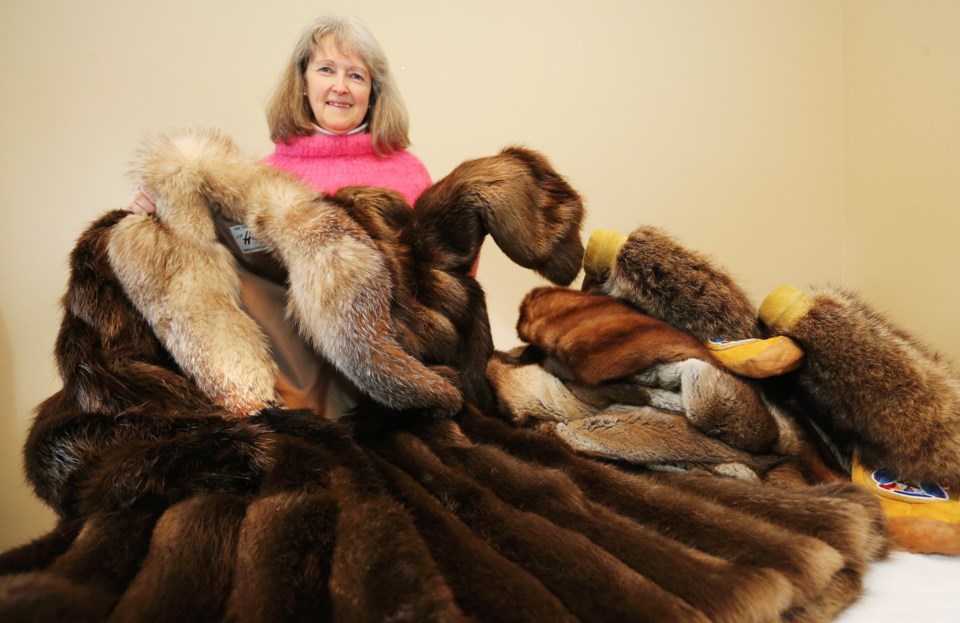When the package from Victoria arrived at the community sewing group in Kugluktuk, Nunavut, the women put it in the middle of their circle.
“Everyone was quiet and polite. Then someone said, ‘Can we open it?’ ” recalled Myste Anderson, who has lived in the small Arctic hamlet near the Northwest Territories border for the past nine years. The population of about 1,400 is mostly indigenous people.
“When [the women] opened it and saw the fur coats, there were a lot of smiles, taking turns looking them and putting legs into the coat arms, saying things like, ‘These would make great boots.’ ”
Anderson and her friend Gail Pettinger, who lives in Victoria, organized the shipment of used fur coats to be sent from the capital region this fall. The upcycling experiment was so successful, they’ve sent another hockey bag full of coats since, and plan on co-ordinating a large container to be sent by land and barge next summer.
“We live in the balmiest climate in Canada and almost all of us have old fur coats from our mothers and grandmothers that we don’t wear. But it’s hard to just get rid of them,” said Pettinger, who came up with the idea to send fur coats to the Arctic.
Fur is a necessity in that part of the world, where temperatures drop below zero for nine months of the year and get as cold as -65C with the windchill. Fur and leather are also very expensive in the Arctic. Those who don’t have access to hunting spoils can pay $100 to $200 for a small seal pelt.
Pettinger pitched the plan to Anderson in a Skype conversation.
Anderson suggested the fur coats would be well-used in the community’s sewing group, where women of all ages and levels learn and make things together.
“For the indigenous women, working with fur is an art that they pass on,” said Pettinger, who was thrilled with the idea.
The first shipment of coats she sent were collected from friends by word of mouth. They included a silver fox stole one of the women from the sewing group used to make a hood for her grandmother, and donors put notes in some of the pockets saying who the coats were from and the history behind them.
“The ladies were so happy to get the coats. They said it was so nice for people to do that for them,” said Nancy Kadlun, the co-ordinator for the Brighter Futures program that hosts the sewing group. She said they meet twice a week and often end up buying furs to hand-sew mitts, shoes and small parkas for family members.
“They love to sew and learn and are also busy sharing stories,” said Kadlun, who was working on a pair of mittens to send back to one of the coat donors as a gift.
When word that Pettinger was collecting coats to send to the Arctic spread through a radio interview and by mouth after the first shipment, more donations rolled in. Her second shipment, sent in late November, included a black sealskin and lamb shearling coat, a fur collar and several full-length leather and fur items.
“One couple drove from Quadra Island to drop off coats,” Pettinger said.
Cheryl Shoji slipped a card into the coat she donated, telling the sewing circle that it was her grandmother’s coat. She wore it a few times in Edmonton but since she’s been in B.C. for decades, it has sat in her basement. “I was reluctant to give it up, but I found this program,” she wrote, asking the women if they’d mind sending back a photo of the fur being repurposed into other items.
Pettinger said her goal is to collect more fur and leather coats to send. She’s also looking for hockey bags to send them in. One major challenge she’s facing is the costs of sending the coats by air mail. It works out to be $20 to $30 per item. Her plan is to raise funds to help with the shipping costs and also look at sending the coats by barge during the few summer months when the ice has melted enough to make this possible.
For more information on the furs to the Arctic program, contact: [email protected]



